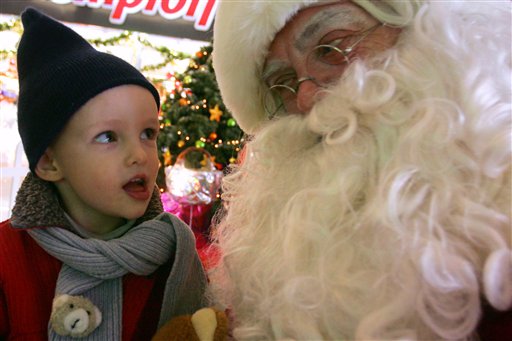The traditions of Secret Santa

A man dressed as Santa Claus, right, listens to a young boy after the boy posed with Santa for a photograph in a Calais shopping center, northern France, Tuesday, Dec. 19, 2006. The shopping center is employing the performer during the Christmas period and is offering to let customers’ children to have their photo taken with Santa. (AP photo/Michel Spingler)
Chances are, you’ve heard of the “Secret Santa.” Chances are, you’ve participated in one. Even if you haven’t, it’s a simple concept: a group of people pick names of others in the group to give a gift to. When it comes time for the exchange, your secret santa is revealed as they give you a gift, and you give one to the person you were assigned to. Where did this long-standing tradition come from?
The concept started in Scandinavia, where it was known as “Julklapp”. The myth was that one should knock loudly before entering the living room, throw a gift in, and leave. Nobody would see the gift, which made its deliverer a mystery. Hence, “secret”. For the more modern game, someone’s secret Santa is usually exposed during the gift-giving process. It’s unclear how the initial idea came about, but it’s popularity rose around the world.
In Scandinavia, instead of writing the recipient’s name, a short, funny message would be written on the gift, intended to make someone laugh before opening it. People would often try to guess who gave them their gift based off of the note and the handwriting associated with it. In the United States, it’s often just given to the other person without a name.
There are many ways to play Secret Santa around the world. Aside from the usual game (as described above), here are some variations to spice up the fun.
The White Elephant
Everybody brings one gift to the event to be opened, and the presents are stacked together in a pile. There’s no labeling or note on any of the gifts, so the identity of the gift giver can remain anonymous. Numbers are put in a hat to decide the order of opening.
The first person can pick any gift from the heap to open. After opening, it’s typically revealed who the giver is (if the recipient can’t guess already). This person has to keep the gift, whether they want to or not. Since the presents aren’t for anyone in particular, it’s hard to assume who will pick what and if they’ll enjoy it.
The second person, following suit, picks any unopened gift. This person can choose to either keep whatever item they opened, or take the item opened by the previous person, initiating a gift swap. The first person has no control over it, and cannot veto the gift.
This pattern follows for each person, the higher their number is, the more gifts they have to choose from. The last person to pick their gift has no choice but to unwrap the last present standing. However, they have the choice of any gift they want – they can swap with any item they desire (much to the dismay of others, who may have gotten comfortable with their gift).
The Guessing Game
Taking elements from the Secret Santa, the only difference is that in the Guessing Game, there’s a letter attached to each gift. It’s a requirement before opening the present to guess the person who gave the gift, based on clues in the note and help from other people.
Conspiracy Santa
In a given group of people, everyone has to work together to get a gift for one particular person, without the person catching on. The thread goes on for each person in the group. This variation is most commonly played in schools and workplaces, since it’s a great opportunity to get to know fellow peers.











